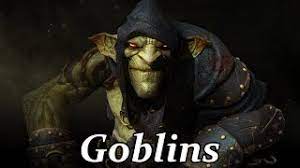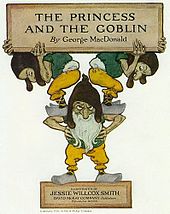A Goblin is a mythical creature of Germanic and British folklore, often believed to be the evil, or merely mischievous, opposite of the more benevolent faeries and spirits of lore. Like many such creatures, there is no single version of a goblin; the term is more generic for those small creatures that live in dark places and cause trouble, but in more recent years, the term has become more concentrated on green creatures that live in caves and terrorize children.
Origin
Despite local variations, goblins have almost universally been described as troublemakers. They are either simply tricksters and mischievous, like immature children, or malevolent, evil-doers dangerous to human beings. Like many similar creatures, they have the characteristics of spirits rather than beings existing in the physical world. Thus, they share similarities with ghosts and also with demons as associated with some Christian teachings and lore.

History
Goblins are grotesque fairies that can range from dwarf height to human height. Various (sometimes conflicting) abilities and attributes have been given to them. Some accounts claim they are mostly invisible to the human eye and thus act as phantoms. However, even in traditions where they are invisible, it is still widely known (although how remains mysterious) what they look like underneath their invisibility. They are usually believed to be shorter than human beings. Depending upon the source, they can either be stout or thin. Their brow is fully covered with thick hair and their mouth is filled with yellowed, crooked teeth.

Depictions
Goblins are often depicted as possessing a coarse, raspy sounding, and slightly high-pitched voice, speaking human languages along with their own, and possessing a cunning intellect. In recent depictions, goblins have been portrayed as green in color, but this is only a modern tradition. There is no consensus on the origin of goblin myths. Since goblins are similar to faeries and other spirits of Europe, they may share a similar origin. Many scholars believe that such creatures came out of an interest in Paganism and its mysticism, especially the belief in nature spirits, and magic.
Goblins could come from the belief that, along with virtuous pagans, there were evil ones that became evil spirits. Sir Walter Scott, in his Letters on Demonology and Witchcraft, ascribed gnomes, kobolds, and goblins, along with Scottish bogles to all correspond with a caricature of the Sami people.
Culture
Numerous role-playing fantasy games incorporate goblins. Following the traditions of the inherently evil and malicious, with varying coloring, and generally matted and filthy hair. This type of goblin appears in Dungeons & Dragons. The distinctive green-skinned, hairless, capricious, and generally amoral (rather than evil) goblins created for Warhammer are direct progenitors of goblins in more modern games, such as those in the Warcraft Universe or Magic: The Gathering.
In the film, goblins are sometimes given a different representation. In the Jim Henson film Labyrinth, Goblins figure prominently. Jareth the Goblin King, a powerful sorcerer, commands a legion of foul, diminutive, largely incompetent creatures. In other animated fairy tales and more child-oriented programs, goblins once again become more mischievous than evil. Although they are often still depicted as frightening.

